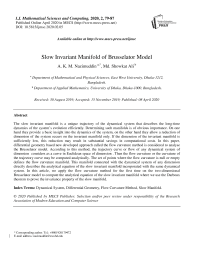Slow Invariant Manifold of Brusselator Model
Автор: A. K. M. Nazimuddin, Md. Showkat Ali
Журнал: International Journal of Mathematical Sciences and Computing @ijmsc
Статья в выпуске: 2 vol.6, 2020 года.
Бесплатный доступ
The slow invariant manifold is a unique trajectory of the dynamical system that describes the long-time dynamics of the system’s evolution efficiently. Determining such manifolds is of obvious importance. On one hand they provide a basic insight into the dynamics of the system, on the other hand they allow a reduction of dimension of the system occurs on the invariant manifold only. If the dimension of the invariant manifold is sufficiently low, this reduction may result in substantial savings in computational costs. In this paper, differential geometry based new developed approach called the flow curvature method is considered to analyse the Brusselator model. According to this method, the trajectory curve or flow of any dynamical system of dimension considers as a curve in Euclidean space of dimension . Then the flow curvature or the curvature of the trajectory curve may be computed analytically. The set of points where the flow curvature is null or empty defines the flow curvature manifold. This manifold connected with the dynamical system of any dimension directly describes the analytical equation of the slow invariant manifold incorporated with the same dynamical system. In this article, we apply the flow curvature method for the first time on the two-dimensional Brusselator model to compute the analytical equation of the slow invariant manifold where we use the Darboux theorem to prove the invariance property of the slow manifold.
Dynamical System, Differential Geometry, Flow Curvature Method, Slow Manifold
Короткий адрес: https://sciup.org/15017542
IDR: 15017542 | DOI: 10.5815/ijmsc.2020.02.05
Список литературы Slow Invariant Manifold of Brusselator Model
- Andronov, A.A., Chaikin, S.E (1937). Plane Theory of Oscillators, I, Moscow.
- Tikhonov, A.N. (1948). On the dependence of solutions of differential equations on a small parameter, Mat. Sbornik N. S., 31:575–586.
- Levinson, N., (1949). A second-order differential equation with singular solutions, Ann. Math, 50:127–153.
- Fenichel, N. (1971). Persistence and smoothness of invariant manifolds for flows, Indiana Univ. Math. J, 21:193–225.
- Fenichel, N. (1974). Asymptotic stability with rate conditions, Indiana Univ. Math. J, 23:1109–1137.
- Fenichel, N. (1977). Asymptotic stability with rate conditions II, Indiana Univ. Math. J, 26:81–93.
- Fenichel, N. (1979). Geometric singular perturbation theory for ordinary differential equations, J. Differ. Equ., 31: 53–98.
- Wasow, W.R. (1965). Asymptotic Expansions for Ordinary Differential Equations, Wiley-Interscience, New York.
- Cole, J.D. (1968). Perturbation Methods in Applied Mathematics, Blaisdell, Waltham.
- O’Malley, R.E. (1974). Introduction to Singular Perturbations, Academic Press, New York.
- O’Malley, R.E. (1991). Singular Perturbations Methods for Ordinary Differential Equations, Springer, New York.
- Ginoux, J.M. and Rossetto, B. (2006). Differential geometry and mechanics applications to chaotic dynamical systems, Int. J. Bifurc. Chaos, 4(16): 887–910.
- Ginoux, J.M., Rossetto, B. and Chua, L.O. (2008). Slow invariant manifolds as curvature of the flow of dynamical systems, Int. J. Bifurc. Chaos, 11(18): 3409–3430.
- Ginoux, J.M. (2009). Differential geometry applied to dynamical systems, In: World Scientific Series on Nonlinear Science, Series A, 66, World Scientific, Singapore.
- Ginoux, J.M.and Llibre, J. (2011). The flow curvature method applied to canard explosion, J. Phys. A Math. Theor., 44: 465203.
- Ginoux, J.M., Llibre, J. and Chua, L.O. (2013). Canards from Chua’s circuit, Int. J. Bifurc. Chaos, 23(4): 1330010.
- Ginoux, J. M., & Rossetto, B. (2014). Slow invariant manifold of heartbeat model, arXiv preprint arXiv:1408.4988.
- Ginoux, J. M. (2014). The slow invariant manifold of the Lorenz–Krishnamurthy model, Qualitative theory of dynamical systems, 13(1): 19–37.
- Anguelov, R. & Stoltz, S. M. (2017). Stationary and oscillatory patterns in a coupled Brusselator model, Mathematics and Computers in Simulation, 133(C): 39-46.
- Alqahtani, AM. (2018). Numerical simulation to study the pattern formation of reaction–diffusion Brusselator model arising in triple collision and enzymatic, Journal of Mathematical Chemistry, 56(6):1543-1566.
- Nazimuddin, A. K. M. and Ali, M. S. (2019). Periodic Pattern Formation Analysis Numerically in a Chemical Reaction-Diffusion System, International Journal of Mathematical Sciences and Computing (IJMSC), 5(3):17-26.
- Nazimuddin, A. K. M. and Ali, M. S. (2019). Pattern Formation in the Brusselator Model Using Numerical Bifurcation Analysis, Punjab University Journal of Mathematics, 51(11):31-39.
- Prigogine, I. and Lefever, R. (1968). Symmetry breaking instabilities in dissipative systems, The Journal of Chemical Physics, 48(4), 1695–1700.
- Schlomiuk D. (1999). Elementary first integrals of differential equations and invariant algebraic curves , Expositiones Mathematicae, 11: 433–454.
- Llibre J . & Medrado J. C. (2007). On the invariant hyperplanes for d-dimensional polynomial vector fields , J. Phys. A. Math. Theor., 40 : 8385–8391.
- William E. B. & Richard C. D. (2001). Elementary differential equations and boundary value problems, John Wiley & Sons, Inc, New York.


